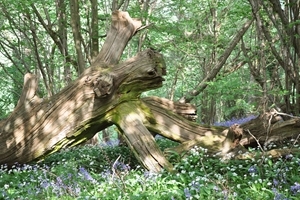 Most of Britain was once covered in broadleaved forest, but today only around 12% of our landscape remains wooded. The composition of those woods has also changed with ancient woodland, which has been continuously wooded since at least 1600 AD, covering only 2% of the UK’s land area. Research shows that 40% of the forest ecosystem is dependent on dead wood. Dead or rotting trees provide homes for a huge range of organisms. Dead wood habitat also occurs on perfectly healthy trees in the form of rotting holes, dead limbs and heart rot where the centre of the tree is decaying.
Most of Britain was once covered in broadleaved forest, but today only around 12% of our landscape remains wooded. The composition of those woods has also changed with ancient woodland, which has been continuously wooded since at least 1600 AD, covering only 2% of the UK’s land area. Research shows that 40% of the forest ecosystem is dependent on dead wood. Dead or rotting trees provide homes for a huge range of organisms. Dead wood habitat also occurs on perfectly healthy trees in the form of rotting holes, dead limbs and heart rot where the centre of the tree is decaying.
Species
- 5,000 British species (about 13% of the total) have life cycles that are dependent on the dead wood environment. Fungi, mosses, liverworts and lichens quickly assemble on dead or dyng wood.
- 750 beetles are linked to dead wood, with species like the stag beetle, which can grow to nearly three inches in length.
- The noctule bat uses tree cavities as a hideaway and many species of birds nest in holes and cracks within trees. Woodpeckers and willow tits excavate their own nesting holes in rotten wood.